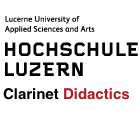Eli Eban
The interview with Eli Eban Eli Eban. [1] orchestral soloist, recitalist, chamber musician and professor at Bloomington School of Music was held on 22 June with a telephone call from Zug, Switzerland, to Baltimore, USA and was edited by Heinrich Mätzener.
On the tracks of the old French School
HM: After the Interviews with colleagues in Switzerland, France, Germany and Austria, I now want to focus on the traces of the old French School in the USA. In the beginning of the 20th century, important French clarinet teachers came to the States and had big influence on the clarinet playing of the of the following generations. Interestingly, the development of the French school in Europe took a significantly different course.
EE: Right.
Eli Ebans Teachers
HM: I asked you to participate in the project because your teachers can be assigned to the tradition of the Old French School. I saw that your teacher was a student of Louis Cahuzac.
EE: Yes, one of my teachers was Yona Ettlinger , a student of Cahuzac, and my other teachers came from the Bonade side, Anthony Gigliotti from Curtis, and Richard Lesser, who was principal in Israel and who had studied with Mitchell Lurie and Anthony Gigliotti, so I had in me both of these French influences.
HM: Having students of Louis Cahuzac and Daniel Bonade as your teachers, I hope in this interview it will make it possible, to understand certain aspects of the development that the French School has undergone in the States.
There is a story, when Bonade came back from France in the 50th, where he was invited to a competition of a class in the Paris Conservatory. He was disappointed of the sound of the new French school . He couldn’t believe it. He went back to the States and followed what he had developed.
I met Richard Stoltzman in New York, David Shifrin in Yale, I made an interview also with John Moses, with Steve Hartman from the New York City Ballet Orchestra, as well as with the soloist Sunny Kang, a former student of David.
EE: Oh, yes, I taught her at Eastman for a year. Also, a wonderful player.
HM: All of these clarinetists are still near the tradition of the old French School.
EE: Yes.
Describing sound quality
HM: How should a clarinet sound today, what would you say, must it be especially beautiful, what is your ideal of sound?
EE: So, I think first of all, a centered sound, meaning something that has a definite shape to it, and for me personally that means beauty of sound.
Thinking of Mozart’s letter to his father Leopold, the sound was the first thing that attracted his ear: „Ach wenn wir nur auch clarinetti hätten! – sie glauben gar nicht was eine sinfonie mit flauten, oboen und clari- netten einen herrlichen Effect macht“ ["Oh, if only we had clarinetti too! - you wouldn't believe what a symphony with flutes, oboes and clarinetti can do for a magnificent effect!]" [1]
, I think, the great composers were attracted to the clarinet’s vocal aspect than its agility and facility. So, for me, always sound has been the most important thing. I took some notes as per your emailed questions and what I think is important, other than a center so that a well-defined shape to the sound, is dynamic control and that the attack, that the beginning of the sound be part of the aesthetic of the sound. Not like: here is the attack and here is the sound.
HM: I think, making attack can be high artistry. You can do with the beginning of the sound different colors. Do you see it in the same way? Do you use different ways to attack a sound?
EE. Yes, like different textures to the tongue, different contact but mostly something different in the ear, different consonant/vowel combination- like a vocalist. I mean I try to do that or share with you that I find this is the hardest thing to do, just to get an even attack in fall dynamics and all registers.
HM. Of course. And then it depends from the reed, from the mouthpiece, from the day. I would like to speak more about the (technique of doing) an attack. I thought going from “outside” (embouchure) to “inside” (voicing).
